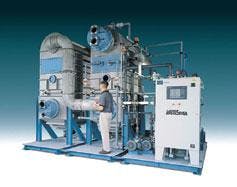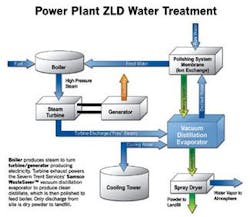Distillation Process Can Yield Zero Liquid Discharge System
By Gary N. Dixon
Many industrial applications produce liquid waste as a by-product of their process. As environmental regulations governing the disposal of industrial wastewater become more stringent, it's imperative that innovative wastewater treatment solutions are used to treat this waste and minimize the environmental impact of disposal.
While numerous technologies exist to treat industrial wastewater, Zero Liquid Discharge (ZLD), a relatively new 'system' approach, is gaining momentum in industrial markets. As its name implies, ZLD is a process involving the reduction to zero of the water that is discharged, resulting in the separation of waste from the wastewater and allowing the treated water to be recycled/reused in the industrial process.
This approach reduces the environmental and financial impact of discharging industrial wastewater since only the waste, usually in solid form, needs to be hauled off site instead of the larger volumes typically associated with a liquid wastewater stream.
When applying a ZLD approach in a power plant application, multi-staged, full distillation, vacuum technology evaporation equipment can be combined with salt-crystallizing spray dryers to recycle process waste from various water contaminating processes (e.g., ion exchange membrane regeneration water from boiler feed water systems).
Such processing can result in clean water that can be economically recirculated through the ion exchange system to provide the very high quality makeup water required by the boiler system. Contaminants will have been so concentrated that they are removed as dry powder from the spray-drying final stage of the distillation system.
The process illustrated in Diagram 1 shows a typical, simple technique for recycling such process wastes and simultaneously reducing wastewater disposal costs for a power plant application. The same approach can be used for wastewater generated in many other manufacturing process industries such as chemical, pharmaceutical, biotech, metalworking, metal finishing, etc.
The equipment will produce very clean distillate from the process waste (e.g., reject streams from the boiler feed system's ion exchange regeneration membrane). Recirculating this distillate for final-stage polishing in a membrane system instead of hauling it for off-site disposal will produce an immediate bottom-line boost for the user.
Typical U.S. industrial wastewater hauling rates run from $0.35 to $1.00 per gallon. A distillation system sized to handle 1,000 gal/hr then, would save hauling 168,000 gallons of wastewater per week and would likely incur operating cost in the vicinity of $0.02/gallon — less if the plant is a steam-producing co-generation facility where steam is — essentially — free. In this case, operating cost could be less than $0.01/gallon.
The wastewater disposal cost savings generated by distillation vs. hauling to a disposal site can easily be seen to amount to more than $50,000/week. If compared to alternate on-site processing, savings likely would be much lower; but even here, the amount saved could be enough to make such a zero-liquid discharge (ZLD) system financially attractive.
Alternative wastewater processing such as using a membrane-only system also offers significant cost savings over hauling, but savings may be reduced by the costs of maintaining the system. The cost of replacement membrane components and the labor required to back-flush membranes in order to restore filtering efficiency and maintain the membrane at its optimum performance level can be prohibitive. Using the ZLD system suggested here, expect operating cost savings in the range of $90,000/year. Typically, the initial capital investment in such a distillation system is offset by the savings in just a year or two.
The ZLD system could tie an existing wastewater-producing process (e.g., an ion exchange membrane regeneration system, a salt-bearing metal rinse, a chemical mixing vat cleanout wash, etc.) together with both a vacuum distillation evaporator, and a spray dryer, (or other crystallizer module).
Given the system's inputs: (1) raw wastewater, (2) boiler fuel, and (3) a small amount of electrical energy, the output is a reusable distillate (very clean, with low conductivity), dry powder, and in the case of a system using a spray dryer final stage, a small amount of clean water vapor emitted to atmosphere.
Such a system eliminates liquid waste, thus creating a Zero Liquid Discharge wastewater pretreatment system. As an example of its use, if a co-gen power plant were to use this system, the boiler feedwater treatment system could be combined with this ZLD disposal system such that this one set of components would comprise the complete recycling system for cleaning and reusing spent boiler feed water.
Such a ZLD system would eliminate off-site disposal costs (hauling and final disposal) associated with liquid waste and would eliminate all wastewater hauling: a highly desirable objective given the liabilities associated with over-the-road transportation of contaminated water. It would recycle almost the entire boiler feed stream's regenerated effluent and, in the case of a co-gen plant, it would do so at almost zero labor and energy cost due to the plant's production of virtually "free" steam heat energy (the energy input required to operate the vacuum distillation evaporator).
The vacuum distillation evaporator is appropriate for use in the metal-working/finishing industries, chemical process industries, and power plants (especially co-gen plants) to maintain boiler feedwater quality, reduce generic industrial wastewater disposal cost, and eliminate liquid waste discharges.
The system can be used effectively in industrial wastewater recycling applications involving as little waste as a thousand gallons/year up to applications in the hundred million-gallon/year range to achieve ZLD.
About the Author:
Gary Dixon is a Senior Application Engineer at Severn Trent Services. He has 17 years experience in the field of industrial wastewater evaporative disposal. Degreed in Engineering Physics, his career includes both design engineering and sales/marketing management within technical product manufacturing firms and consulting groups. For more information about Severn Trent Services' Samsco WasteSaver™ vacuum distillation equipment and ZLD systems contact Gary Dixon at 603.668.7111 or [email protected]


